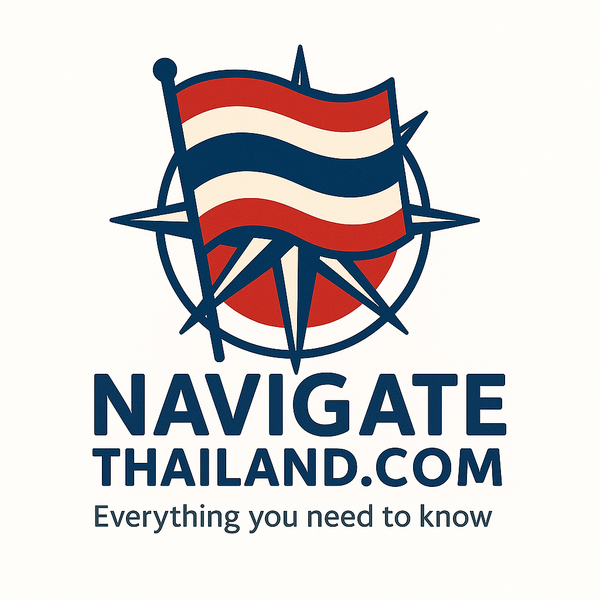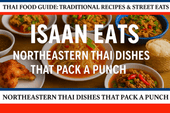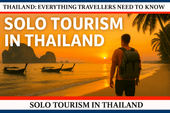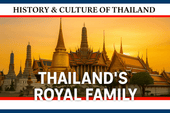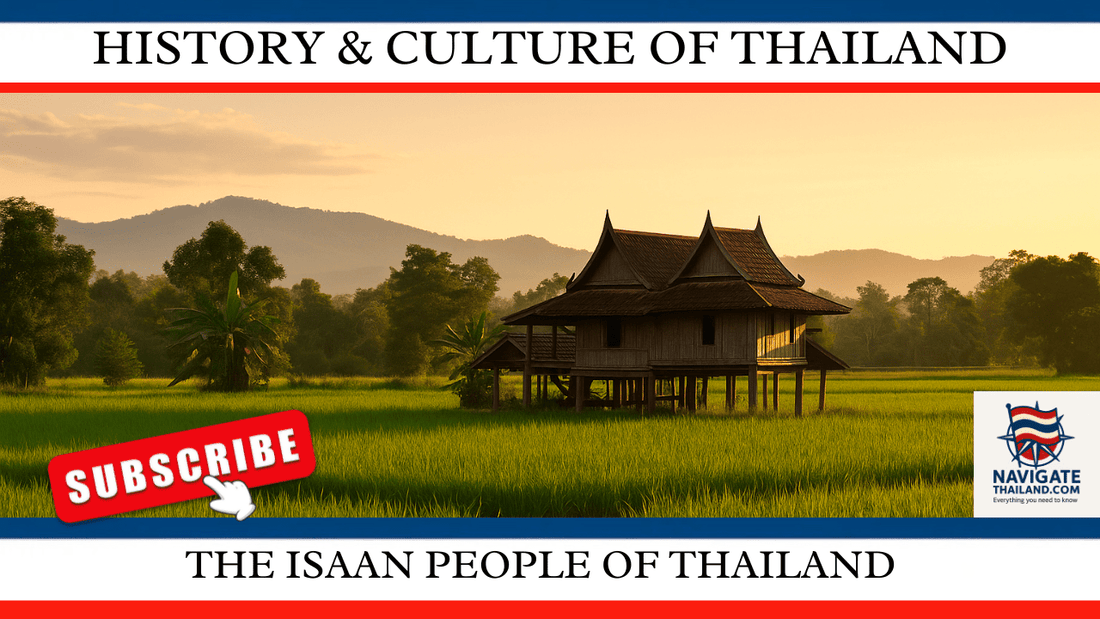
Exploring Isaan: The Heart and Heritage of Northeast Thailand
Share
The Isaan region in Northeast Thailand is a cultural treasure, known for its deep-rooted traditions, rich history, and unique identity. Shaped by Lao roots, centuries of evolution, and a powerful integration into Thailand, Isaan’s story unfolds across vibrant festivals, distinct cuisine, and resilient cultural practices. Here, we delve into the fascinating history of Isaan, the people who call it home, and their influence during some pivotal moments in the 20th century, including World War II and the Vietnam War.
Historical Background of Isaan
From Prehistoric Settlements to the Bronze Age at Ban Chiang
Isaan’s past reaches back thousands of years, with Ban Chiang—a UNESCO World Heritage Site—marking one of Southeast Asia’s most important archaeological sites. Discoveries here reveal an advanced society practicing rice farming, pottery, and metallurgy as early as 1500 BCE. The ancient tools, bronze artifacts, and pottery unearthed at Ban Chiang give us a glimpse into the skills and lifestyles of early Isaan inhabitants.
This legacy of innovation and community-building adds depth to Isaan’s history and underscores its longstanding place in the development of Southeast Asia.
Influence of the Dvaravati and Khmer Civilizations
By the 6th century CE, Isaan was feeling the influence of the Dvaravati civilization, which brought early Buddhism and elements of Hinduism. This was only the beginning; in the 11th century, the mighty Khmer Empire expanded into Isaan, further enriching the region with art, architecture, and spirituality. The Khmer left behind extraordinary temple ruins, like Phanom Rung and Prasat Hin Phimai in southern Isaan. These sites, with their intricate carvings and soaring towers, remain as striking reminders of a past woven with faith, craftsmanship, and cultural exchange.
The Lao Kingdom of Lan Xang and the Formation of Isaan’s Cultural Identity
After the Khmer Empire’s decline, the Lao Kingdom of Lan Xang rose to prominence in the 14th century, infusing Isaan with Lao cultural and linguistic heritage. While officially part of Thailand today, Isaan’s identity remains distinctly Lao in many ways. Even as the Kingdom of Siam integrated Isaan in the 18th century, the people preserved their language, customs, and festivals. This blend of Thai and Lao influences shapes Isaan’s cultural landscape, making it one of Thailand’s most distinct regions.
The Language of Isaan
Isaan’s language—a variant of Lao—continues to be spoken by around 20 million people, making it a significant regional language in Thailand. Linguistically, it belongs to the Tai-Kadai family, bridging Lao and Thai roots. However, historical factors have led to Isaan being spoken but rarely written, as the Thai script became the standard.
During the 20th century, Thailand promoted a policy of “Thaification,” which emphasized the use of Central Thai in education and official contexts across the country, including Isaan. While this integration helped unify Thailand, it also pushed the Isaan language into a primarily spoken role, particularly among younger generations fluent in Central Thai. Despite this shift, Isaan’s language remains an anchor of cultural identity, carrying with it stories, values, and traditions unique to the region.
Culture and Traditions of Isaan
Isaan’s cultural heart beats strongly in its unique traditions, cuisine, and spiritual beliefs. Theravada Buddhism, as practiced across Thailand, forms the region’s spiritual backbone, yet ancient animist beliefs are still woven into daily life. Village rituals often involve offerings to ancestral spirits, showcasing a spirituality that predates Buddhism and adds layers to Isaan’s cultural fabric.
Mor Lam Music and the Spirit of Isaan
No exploration of Isaan would be complete without Mor Lam, the traditional folk music that captures the soul of the region. With heartfelt lyrics, often about love, rural life, and resilience, Mor Lam resonates deeply across generations, keeping Isaan’s stories alive in a distinctly local style. The accompanying dance, lively and expressive, adds to the performance, making Mor Lam a celebrated part of Isaan’s identity.
A Cuisine Loved Across Thailand
Isaan’s culinary contributions are equally significant. Known for bold, unforgettable flavors, dishes like som tam (spicy papaya salad) and larb (spicy minced meat salad) have won over taste buds across Thailand. These dishes reflect Isaan’s agricultural roots and highlight the importance of local ingredients and traditional cooking techniques.
Isaan’s Role in World War II and the Vietnam War
World War II and Anti-Colonial Movements
During World War II, Isaan’s proximity to Laos made it an important base for anti-colonial movements. The Lao Issara (Free Laos) movement, which opposed French colonial rule, found support and refuge among the culturally connected Isaan people. This solidarity, built on shared history and values, played a role in the broader Southeast Asian resistance against both French and Japanese forces during the war years.
The Vietnam War and U.S. Military Presence
Isaan’s strategic location also brought it to the frontlines during the Vietnam War, as the U.S. established key airbases in Udon Thani, Ubon Ratchathani, and Nakhon Phanom. These bases were vital for American operations in Vietnam and Laos, and the influx of U.S. personnel spurred economic growth in the region, with locals finding employment on the bases and in surrounding areas. However, the U.S. withdrawal in 1975 led to economic challenges, emphasizing the region’s dependence on external influences and marking a transformative chapter in Isaan’s recent history.
Conclusion: Isaan’s Enduring Legacy
Isaan stands proudly as a cultural crossroads where Lao heritage and Thai identity converge. From ancient Bronze Age societies to its role in recent global conflicts, Isaan has contributed profoundly to Thailand’s story. Its language, music, and food are celebrated elements of Thai culture, beloved across the nation for their authenticity and flavor.
Today, there’s a growing appreciation for Isaan’s distinct culture, as initiatives to promote regional languages, arts, and heritage gain traction. These efforts are vital for preserving the unique identity of Isaan, ensuring that this culturally rich and historically significant region continues to thrive as an essential part of Thailand’s diverse landscape.
References
1. Higham, C.F.W. (2014). Early Mainland Southeast Asia: From First Humans to Angkor. River Books.
2. Coedes, G. (1968). The Indianized States of Southeast Asia. University of Hawaii Press.
3. Stuart-Fox, M. (1997). A History of Laos. Cambridge University Press.
4. Keyes, C.F. (1967). Isan: Regionalism in Northeastern Thailand. Cornell University.
5. Rhum, M.S. (1994). “Modern Thai Literature: Studies in Isan Literature.” Asian Folklore Studies.
6. Nalty, B.C. (2000). Air Power and the Fight for Khe Sanh. United States Air Force.
7. Evans, G. (2002). A Short History of Laos: The Land in Between. Allen & Unwin.
8. UNESCO World Heritage Centre. Ban Chiang Archaeological Site. Retrieved from UNESCO.
Read more of our Thailand blog series:
Thai Food Guide:Traditional Recipes and Street Eats
Everything Travellers Need to know
Thailand travel ebooks and language guides
Thailand Travel Apparel & Souvenir Gifts
Subscribe to our YouTube channel Navigate Thailand to see our most popular Thailand travel blogs turned into videos:
Navigate Thailand YouTube channel
